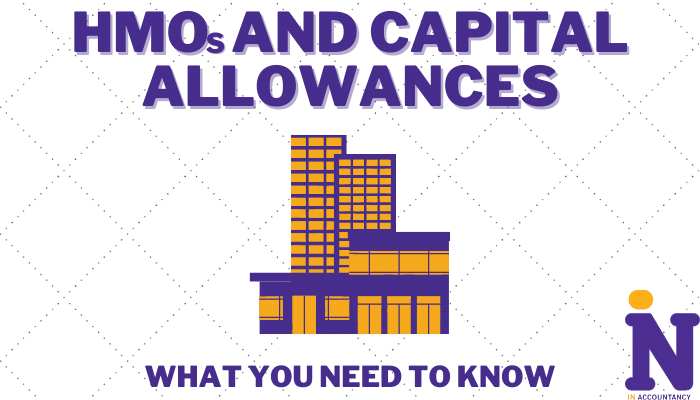The topic of capital allowances is complicated and can appear confusing. This is especially true if you are the owner of a house of multiple occupancy (HMO). However, despite grey areas, the rules about HMO capital allowances are relatively clear-cut. Here, IN Accountancy explains everything you need to know about claiming capital allowances on a property. Contact In Accountancy and see how our team can help you claim capital allowances on a property
What Are Capital Allowances?
Capital allowances are allowable deductions for tax purposes based on money spent on certain fixed assets, such as property, equipment or some vehicles. Some or all of the value of those assets, known as ‘plant and machinery, can be deducted from profits before tax is paid. For example, refurbishing a residential property can be offset against rental profits as revenue costs, costs incurred altering or enhancing the property are considered capital expenditures and are allocated against the property’s purchase price. Any tax relief on capital costs is obtained when the property is sold.
However, landlords can potentially claim back capital costs on certain items (such as fixtures and fittings) and offset those against rental income or Corporation Tax if they are operating as a limited company. This enables landlords to claim back a portion of their capital costs sooner than if they waited until their property was sold. Certain conditions and criteria must be in place to claim capital allowances on commercial property (more on this later).
If you hold your investment property personally, rather than in a limited company, you will pay Capital Gains Tax (CGT) on the profits of any asset you sell or dispose of that has increased in value. Disposing of something doesn’t just mean selling it – you could be giving something away as a gift, swapping it for something else, or gaining compensation for it. Remember that it is only the gain that is taxed, not the overall amount you receive. CGT is only payable on certain items if your total annual gains exceed the Capital Gains Tax (CGT) allowance for that year. The allowance for 2022-23 is £12,300.
Capital Allowances For Residential & Single Let Property…
As is often the case with tax matters, the lay of the land is somewhat complicated for landlords hoping to claim capital allowances. This system is most beneficial to landlords with expensive refurbishments. Having said that, capital allowances are not claimable for single-let properties (a house or apartment let to one tenant) or residential properties without self-contained rooms. HMRC classes these properties as “dwellings” or “dwelling houses”.
Can HMOs Claim Capital Allowances?
Capital allowances are not claimable for houses of multiple occupancy (HMOs) with several individual bedrooms and shared facilities, like kitchens and bathrooms. But, for HMOs consisting of entirely self-contained rooms that provide all the facilities required for day-to-day domestic living, the room is considered the “dwelling house”. This means that the common areas between each “dwelling” – like hallways and staircases – could be considered for HMO capital allowances on any qualifying plant and machinery found in those areas.
The vast majority of HMOs will not qualify for capital allowances. This is because most landlords follow the standard arrangement of several individual bedrooms with shared facilities. Therefore, they do not meet the self-contained requirement, typically consisting of cooking and washing facilities and, most likely, a kitchenette, loo, and shower or bath. Moreover, even if they did qualify, the benefits of HMO capital allowances are unlikely to be worth it, given the expense of organising the required survey.
Scenario 1: Landlord A rents a four-bedroom property to a group of students in a city centre. The property has a shared kitchen, several shared bathrooms and no ensuites. This landlord CAN NOT claim capital allowances.
Scenario 2: Landlord B rents five one-bedroom studios in an HMO. Each contains a small kitchenette and a modest toilet and shower area. This landlord CAN claim capital allowances for certain items in common areas.
What About Inherited Capital Allowances?
Since 6 April 2014, capital allowances can only be inherited from a previous homeowner if an individual has claimed the allowance in a tax return prior to sale. This also pre-supposes that the previous homeowner has formally agreed on a value for capital allowances within two years of the transfer. The seller will need to include the value of capital allowances in the sellers’ legal pack and the new buyer then “inherits” it as part of the purchase.
Where a property is purchased, the new owner must be able to provide evidence that capital allowances can be claimed on inherited assets from a past owner. Unless appropriate evidence is provided, capital allowances cannot be claimed. However, assuming the property is a self-contained HMO, landlords of properties purchased after 6 April 2014 can claim HMO capital allowances for certain capital expenditure that has been spent on common areas.
Contact IN Accountancy for advice
We hope this article goes some way towards clearing up any confusion about HMO capital allowances. Bear in mind that capital allowances are not available for all residential properties. It is only HMOs with entirely self-contained rooms that qualify. Even then, capital allowances on commercial property can only be claimed for common areas, which include staircases and hallways. Therefore, the majority of HMOs will not qualify for capital allowances.
Capital allowances can only be inherited from a previous homeowner if an individual has claimed the allowance in a tax return prior to the sale. The previous homeowner also needs to formally agree on a value for capital allowances within two years of the transfer. Some landlords may decide that the modest windfalls available for claiming capital allowances on a property do not justify the admin or expense of having a property surveyed.
If you are the owner of an HMO property and would like any further information about capital allowances for commercial property, the IN Accountancy team can give you all the advice and guidance you need. For further details about HMO capital allowances or any of our accounting services, please contact us on 0161 456 9666 or email [email protected]. We can arrange a free consultation call to discuss your options in more detail.







